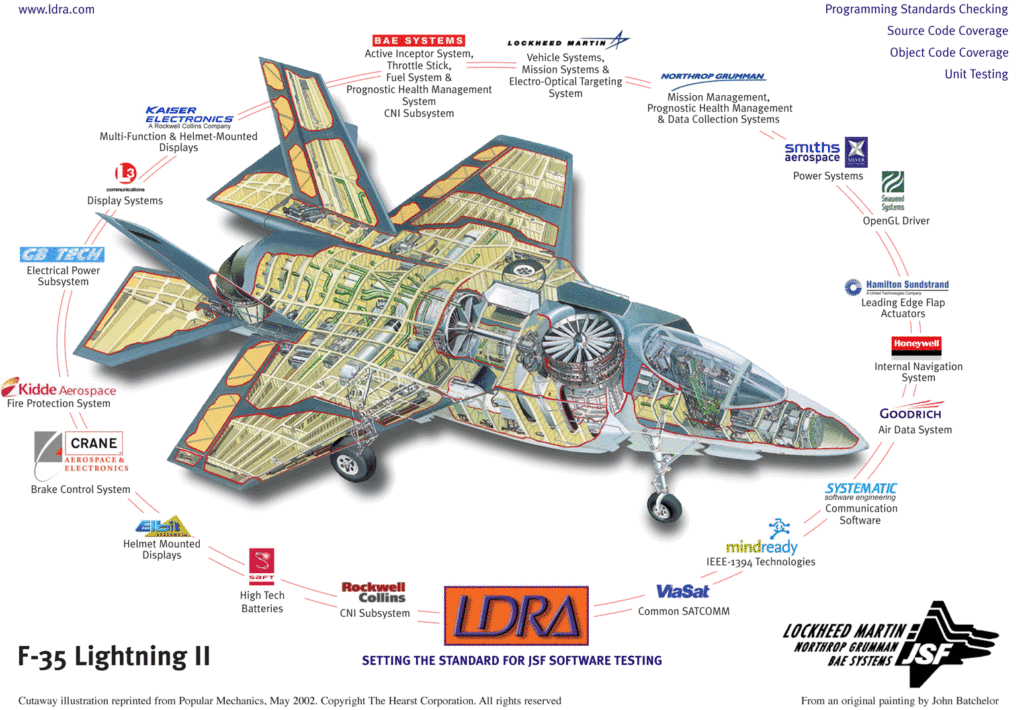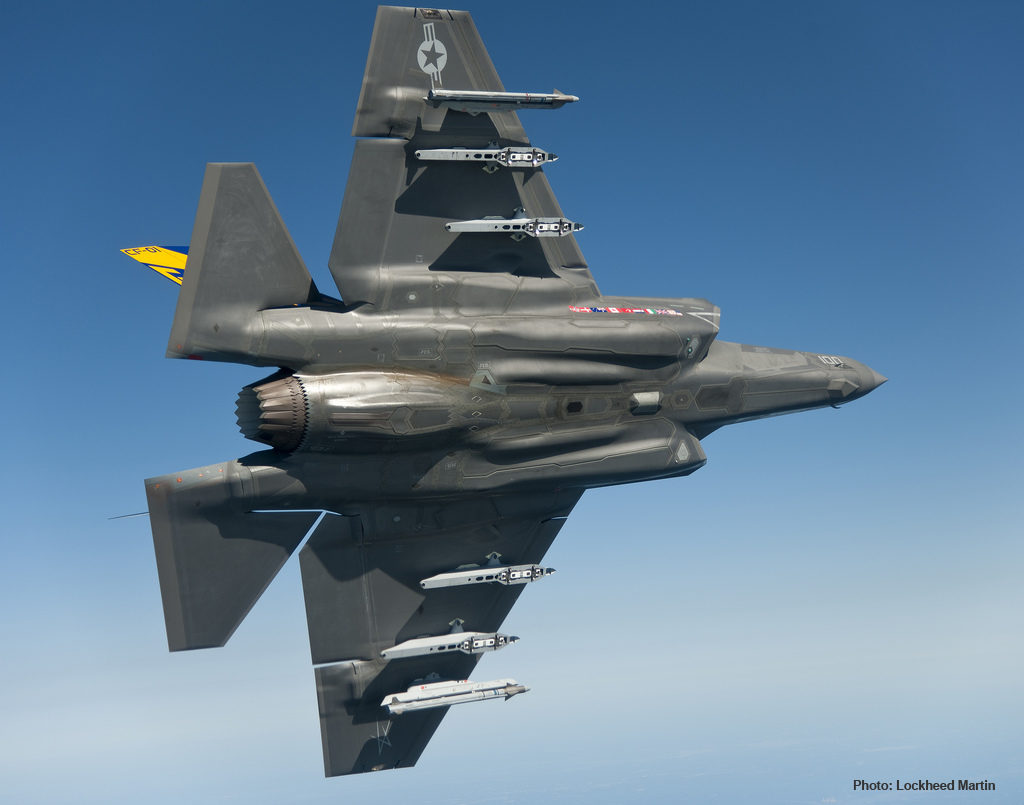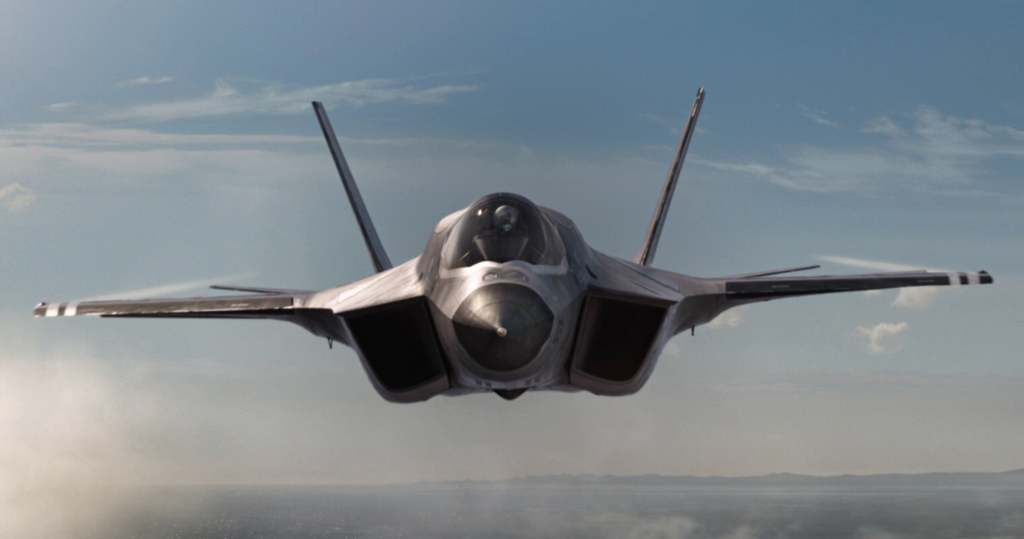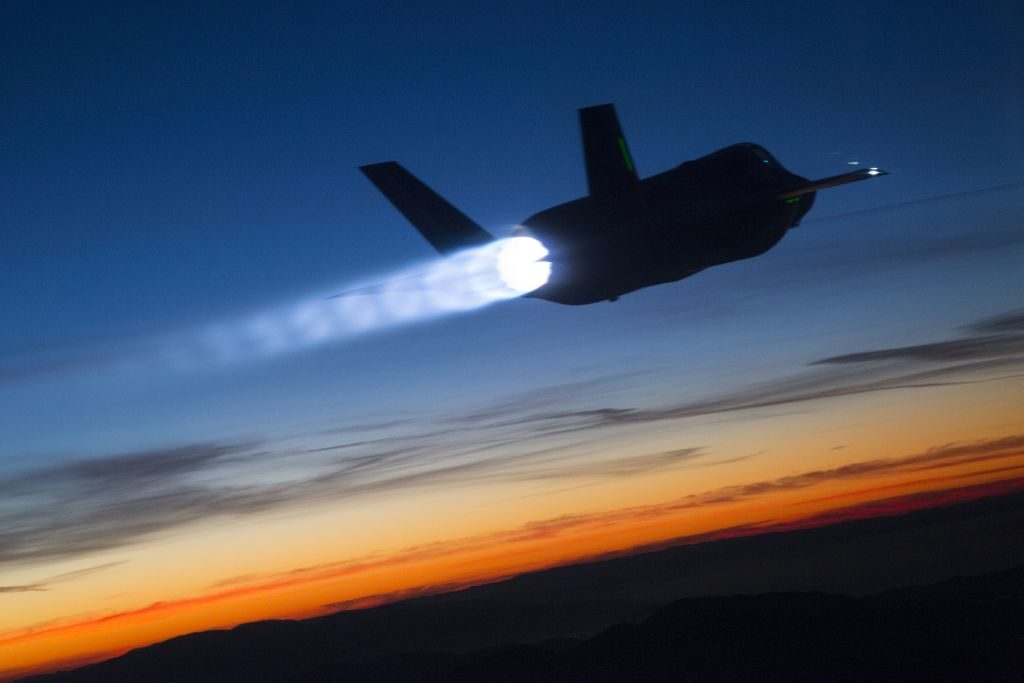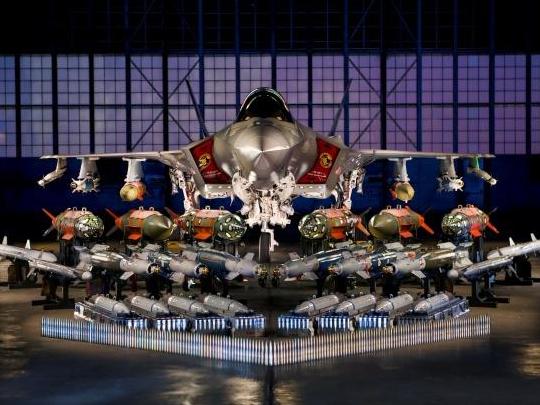The Most Expensive Weapon Ever Built
MILITARISM, 27 Mar 2017
Daniel Soar | London Review of Books – TRANSCEND Media Service
27 Mar 2017 – On the night of 12 January, there was a series of explosions at Mezzeh military airport on the outskirts of Damascus. A few warehouses were destroyed but no one died. The Syrian government blamed rocket attacks launched from inside Israel. The targets were missile systems, sources close to the Israeli government said, that could have been delivered to Hizbullah in Lebanon. According to some reports, however, the attacks were carried out not by rockets but by fighter jets – specifically, the Lockheed Martin F-35 Lightning II, the Joint Strike Fighter, a US-built ‘fifth generation’ stealth jet with super-advanced avionics that has been under development for the last twenty years at a cost of many billions of dollars. In early March, a reporter for the Figaro, Georges Malbrunot, said that according to French intelligence sources the strikes had unquestionably been carried out by a pair of F-35s: not only that, but one of them had gone on to buzz Assad’s palace in a fuck-you show of force.
The F-35 is the most expensive weapon ever built. Israel took delivery of its first two exemplars a month before the Mezzeh raid, and it’s worth bearing in mind that no one with any knowledge of how air forces operate thinks it’s remotely likely that the IAF would have risked its new baby so soon, and on such a trivial mission. Still, it never hurts to give people a hint of what you might be capable of. Israel is very proud of its machines. Four thousand people were invited to see the two F-35s arrive at Nevatim air base in the Negev on 12 December, after a complex journey from their base in Texas – six days, two layovers, at least ten mid-air refuellings. Unembarrassed by a slight extra delay (spectators were kept waiting for six hours thanks to fog over northern Italy), Netanyahu gave a rousing speech celebrating the ‘long arm’ of Israel’s defence equipment. ‘This long arm was just made longer and mightier today,’ he told the assembled VIPs, among whose number were the CEO of Lockheed, Marillynn Hewson, and Obama’s outgoing defence secretary, Ash Carter, who had helped seal the deal. Israel is the only country that has been allowed to make significant modifications to the F-35: its variant, nicknamed the Adir (‘the mighty one’), includes a few extra computer systems of Israel’s own devising. There’s a picture of Avigdor Lieberman, Israel’s defence minister, sitting in the cockpit of an F-35 during a visit last summer to Lockheed’s Fort Worth facility: he’s grinning like a little boy. Israel is now down to purchase fifty F-35s, at a total cost of $7 billion. Last September, Obama and Netanyahu signed a new Memorandum of Understanding, according to which Israel is promised $38 billion of military aid over the next decade. Twenty per cent of that money is going to F-35 procurement: a nice subvention of American taxpayer dollars to an American company, with the bonus of providing the IAF with two squadrons of the baddest fighter jet on the planet.
But a few hours before the Adirs landed in all their glory – just check out the promotional shots of them flying into the sunset – Donald Trump, then still president-elect, tweeted: ‘The F-35 program and cost is out of control. Billions of dollars can and will be saved on military (and other) purchases after January 20th.’ Lockheed Martin’s shares immediately dropped 4 per cent. Trump had a point, though. Over the lifetime of the project the US is expected to have spent $1.5 trillion designing, building and maintaining 2500 planes for its own use: enough to forgive the entire nation’s student debts, or pay for the healthcare of every low-income American family for the next three years, or build a border wall that encircles the Earth four times. The Joint Strike Fighter programme was launched in the mid-1990s under the Clinton administration, with the aim of developing an aircraft that could for the first time be adapted for use by three separate branches of the US military – the air force, the navy and the marines. It would have to be stealthy – hard to detect by radar – and it would have to be able to dance rings in the skies around any nimble jet the Russians or Chinese might come up with. It would also have to be able to bomb targets on the ground five hundred miles away from base – an impressive range, for a fighter – and operate from the deck of a heaving warship at night and, if push really came to shove, hover and land like a helicopter. The last mass-produced fighter jet that did that, the British-designed Harrier, which unfortunately couldn’t quite break the sound barrier, entered service in 1969, did tours in the Falklands War, and had possibly the worst accident rate of any military plane in history: by 2002, a third of the fleet had been lost in non-combatant crashes, killing (among others) 45 marines.
Given that the contract to build the Joint Strike Fighter could mean a job for life for anyone working on it – federal funding for the programme exceeded the GDP of a small European country – it mattered quite a bit to the various companies bidding for the tender that they come up with a winning design. When, in 1996, a consortium led by McDonnell Douglas proposed a plane that effectively had no tail – they left out the vertical fins that provide stability in flight – they were dropped from the competition: punishment for trying to be too clever. The loss of future revenue was so devastating that McDonnell Douglas – despite being responsible for the F-15 Eagle and F/A-18 Hornet, both of which performed handily in the first Gulf War – was forced to cease independent operations and was soon bought out by Boeing. In 2001, after the finalists had demonstrated their prototypes, Lockheed Martin was finally announced as the winner of the JSF competition, with three variants on the basic design: the F-35A, a plane that takes off and lands conventionally, for use by the air force; the F-35B, which has a great downward-pointing fan behind the pilot that allows it to hover, a bonus for the marines; and the big-winged, long-range F-35C, engineered to operate from navy aircraft carriers. For the next 15 years, as costs escalated and delays increased, naysayers complained that the American weapons industry’s proudest achievement was a turkey: the plane was too heavy, too complicated, too busy trying to be all things to all men – and too darned expensive.
But the expense was largely the point. An enormous project brings an enormous number of jobs, and Lockheed sensibly ensured that everyone and his neighbour was invested in keeping it from going belly-up. The joke term for this is ‘political engineering’: for all its rivets, bearings, shafts, ducts and pipes – as well as its fibre optics and sensor systems and radar and onboard computers – the F-35 programme now involves more than 1200 suppliers in 45 US states, accounting for forty thousand jobs in Texas alone. It’s a brave congressman who will stand up and complain about appropriations when hordes of sizeable businesses are going to have at him for it. So Congress barely peeped as costs soared – though there were a few notable holdouts, like Senator John McCain, who called it ‘a scandal and a tragedy’. McCain is a leading representative of a dissident American military tradition that prefers light and agile to massive and lumbering, but it may not be insignificant that his home state, Arizona, is one of the few where Lockheed has recently shed jobs rather than piled them on. (What Arizona has instead of multiple Lockheed facilities is the 309th Aerospace Maintenance and Regeneration Group at Davis-Monthan Air Force Base, aka the Boneyard, a place where decommissioned military aircraft go to die. The dry desert air has proved invaluable for preserving metal. At current count, there are – among its thousands of abandoned hulks – fifty dead BAE Harriers, 167 dead F-15s and 467 dead F-16s. In satellite imagery, the matchbox planes – neatly arranged by size and type – look like the playthings of some obsessive giant-child.)
Spreading the load and marshalling a coalition of the willing is of course standard operating procedure for the US defence industry. You need to get all those makers of grommets and clamps onboard. But in the case of the F-35, where Lockheed and the Pentagon have really innovated is in taking the campaign global. The last stealth fighter the US deployed, the F-22 Raptor, was for internal consumption only: just 187 were built, and because export was prohibited and the suppliers were mostly domestic, the price per aircraft remained high and it never really took off (metaphorically speaking – it’s seen plenty of action over Syria). The F-35 was conceived on a totally different model: from the beginning, a large number of allied nations would be involved in its development and production. In 2001, Blair’s minister for defence procurement, Lord Bach, was on the podium in Virginia for the announcement of Lockheed’s winning bid: the UK, as a ‘major partner’ in the programme, nominally had a say in the decision, having contributed a couple of billion towards development costs and committed to buying 138 of the finished product. The following year, the Australian prime minister, John Howard, was spotted at the Willard Hotel in Washington DC meeting with Lockheed executives: he came out after putting in an order for 72 planes, despite continuing to pretend that Australia’s door was open to salesmen from other countries (a representative from France’s Dassault Aviation, Daniel Frémont, who had just relocated to Sydney to negotiate a multi-year contract to supply the RAAF with a few squadrons of the Rafale fighter jet, was somewhat put out when he found that the door had secretly been shut in his face). F-35 customers now include Turkey, Italy, Canada, Norway, Japan, South Korea, the Netherlands and Denmark.
It helps considerably that many of these customers have more than just a few tonnes of precision-engineered titanium to gain from any deal: the beauty of the JSF project is that everyone can bring something to the party. In a Lancashire workshop, for instance, BAE Systems is building a section of the aft fuselage, including the tail, for every F-35; along with other contributions from all over the world, these pieces are then shipped to Texas for final assembly. This means that every F-35 sale is a boost to the coffers of Britain’s own largest arms company. (BAE has also been allowed to do the foldy bits at the end of the wings.) And the opportunities are everywhere. There are aluminium sheets from Milton Keynes, electronic modules from Billingstad, circuit boards from Ankara, hydraulics from Melbourne, wiring systems from Rotterdam, manifolds from Adelaide, wing parts from Turin and actuators from New York. So when Trump threatened to slash the cost of the F-35 programme, or divert some of the custom to cheaper competitors, it wasn’t only American defence contractors who were in the firing line. Everyone had something to lose. On 30 January, ten days after taking office, Trump announced that he had negotiated $600 million off the price tag of the next batch of F-35s. Lockheed’s CEO chose not to shatter his illusion, but it turned out that the next ninety planes were always going to be cheaper anyway – by between 6 and 7 per cent, or $550 and $650 million. The more you build the cheaper they get, thanks to economies of scale. Happily for everyone involved, this also means that more get sold. The ‘military-industrial complex’ turns out to be very simple: the juggernaut has its own momentum. Once it’s rolling it can’t be stopped, even if you’re Donald Trump, something he finally came to acknowledge on 16 March, when his budget plan for the next fiscal year allowed for the ramping-up of F-35 production as part of a proposed 10 per cent increase in overall military spending.
*
Meanwhile, at RAF Marham in Norfolk, the air base is scrambling to ready itself for the first batch of British-owned F-35s, due for delivery in summer 2018. Facilities are being built and contractors are contracting subcontractors and £300 million is being spent on kitting the place out for Logistics Operations and Integrated Training and Maintenance and Finish. All this activity, required by Lockheed, is a miniature version of what’s going on at the big brother base down the road, RAF Lakenheath in Suffolk, home to the 48th Fighter Wing, or Liberty Wing, the US Air Force’s frontline fighter unit for European operations. There’s a lot of getting ready to be done. Future F-35 pilots from all allied customer nations have been training in the US, in simulators and in the air, including at Edwards Air Force Base in southern California, where, in 1947, Chuck Yeager became the first person to break the sound barrier, in the experimental rocket-powered X-1. (As indelibly recorded by Tom Wolfe in The Right Stuff, Yeager was a pilot of the old school, who trusted his instincts: he scoffed at the engineers who were concerned that at speeds greater than Mach 1 the plane might stop working aerodynamically altogether and fall out of the sky; knowing better, he just climbed in – painfully, since he had broken a rib or two in a riding stunt a couple of days earlier and had to use a broom handle to close the cockpit roof – and flew the thing at 820 mph.)
Test pilots who have been tasked with what’s known as ‘extending the flight envelope’ – it’s weird how much of 1980s business jargon derives from air force terminology – have found that the F-35 performs very creditably. Thanks to its stealth requirements, with its weapons all stored internally to stop them alerting enemy radar, it’s an ugly, fat-bellied thing – though not as ugly as Boeing’s rejected prototype for the JSF competition, the X-32, which looked like a yawning whale. But it flies well. At this year’s Red Flag – an annual simulated war-games exercise conducted over the mountain ranges and salt flats of Nevada – it achieved a kill ratio of 20:1, meaning that for every twenty enemy aircraft downed, only one F-35 was lost. Sure, with a top speed of only Mach 1.6, it’s slower than a Russian Sukhoi Su-35, which on the turn can possibly outrun some of the air-to-air missiles the F-35 will carry. Nor does it have the high thrust-to-weight ratio of a Eurofighter Typhoon, which puts it at a disadvantage when it comes to manoeuvrability during close-range encounters. Even so, Major Morten Hanche, the first pilot from the Royal Norwegian Air Force to fly the F-35, was impressed, as he told readers of a Norwegian Ministry of Defence blog: thanks to its excellent braking performance and its agility at high angles of attack, ‘the F-35 sticks on like glue, and it is very difficult for the defender to escape.’
But this isn’t why pilots are excited. One of the gizmos that comes as standard with every F-35 is a carbon-fibre helmet with a display projected onto the visor, its wizardry the work in part of Israel’s Elbit Systems. Each has to be custom-fitted to an individual pilot’s head using a bit of 3D modelling. They cost $400,000 apiece: another figure to snort at, perhaps, but then each AMRAAM missile costs $400,000 too, and the military thinks nothing of letting loose a few of those – so it’s not really a lot of money in the scheme of things. As well as the usual flight stats that a pilot would see in a traditional heads-up display – airspeed, heading, altitude – the F-35 helmet beams in the pictures gathered by six infrared cameras mounted on the outside of the airframe. This means that just by turning his head the wearer can see what’s above him, behind him and even below the aircraft’s floor.* From his point of view, he’s effectively flying an invisible plane. In front of him is a series of further touchscreen displays, which can be reconfigured with a swipe of the glove to show any amount of radar and targeting information he might need (it’s called the ‘symbology’ – Dan Brown should be pleased). Picture of enemy airfield not clear? Click. The active radar array will scan a high-resolution image of the area of interest. Then all the pilot needs to do is touch a point on the map and the selected weapon will take it out in seconds. Click. Another hangar gone. Simultaneously, systems outside the plane – other aircraft, satellites, ground control – are constantly sending in streams of data for the F-35’s computers to analyse and display. Friendly aircraft are indicated in green on the radar screen, potential threats are yellow and enemies red. Unless you’re colour-blind, it all makes operating a deadly aircraft so very simple: what’s not to like?
It seems to be difficult even for some pilots to get out of the mindset that what these planes should still be about is high-altitude fencing: dodging opponents, doing Top Gun-style tricks, looping round for the kill. But thanks to stealth technology and beyond-visual-range missiles – with hypersonic scramjet-based missiles appearing on the horizon soon – no one is in a position to get into dogfights with the US any more. (Especially now that it accounts for a third of all global military spending, or as much – by some counts – as the next ten most profligate nations combined.) The last American fighter jet to be recorded lost to an enemy aircraft was an F/A-18, shot down by an Iraqi MiG in 1991. Aerial warfare has moved to another realm, and it’s a realm of new buzzwords too: ‘fully fused sensor information’, ‘network-enabled operations’, ‘electronic attack’. The man in the pilot’s seat has become just another node in the network, through whom information is filtered: he’s already an anachronism. Even before we have drone swarms of lightweight autonomous vehicles performing air interdiction with the help of artificial intelligence, it isn’t clear how much future there is in piloted warplanes. The combined marketing muscle of all the Lockheeds, Boeings and Raytheons in the world has failed to come up with any definition of what a ‘sixth generation’ fighter would be. This, it appears, is the end of the line. And yet, like all the Eagles and Hornets and Harriers before it, the F-35 is likely to be around for a very long time – for the next forty years at least. It seems odd, in the age of smartwatches and rapid technological obsolescence, that big lumps of metal can be so very enduring, but that’s the way heavy engineering works. It’s hard not to be alarmingly aware of this every time you get onto a London Tube a hundred feet underground and see, as you step over the steel scuff-plate by the door, that this thing has been pounding the tracks since 1973. Machines, once built, are here to stay, and fighter planes are no different. The business of the arms industry is to build and spend, build and spend. It’s all part of the weaponry system.
______________________________________
Daniel Soar is an editor at the LRB.
DISCLAIMER: The statements, views and opinions expressed in pieces republished here are solely those of the authors and do not necessarily represent those of TMS. In accordance with title 17 U.S.C. section 107, this material is distributed without profit to those who have expressed a prior interest in receiving the included information for research and educational purposes. TMS has no affiliation whatsoever with the originator of this article nor is TMS endorsed or sponsored by the originator. “GO TO ORIGINAL” links are provided as a convenience to our readers and allow for verification of authenticity. However, as originating pages are often updated by their originating host sites, the versions posted may not match the versions our readers view when clicking the “GO TO ORIGINAL” links. This site contains copyrighted material the use of which has not always been specifically authorized by the copyright owner. We are making such material available in our efforts to advance understanding of environmental, political, human rights, economic, democracy, scientific, and social justice issues, etc. We believe this constitutes a ‘fair use’ of any such copyrighted material as provided for in section 107 of the US Copyright Law. In accordance with Title 17 U.S.C. Section 107, the material on this site is distributed without profit to those who have expressed a prior interest in receiving the included information for research and educational purposes. For more information go to: http://www.law.cornell.edu/uscode/17/107.shtml. If you wish to use copyrighted material from this site for purposes of your own that go beyond ‘fair use’, you must obtain permission from the copyright owner.
